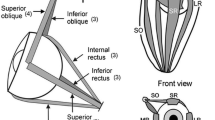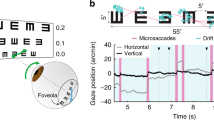Abstract
Smooth pursuit eye movements consists of slow eye movements that approximate the velocity of the eyes to that of a small moving target, so that target image is kept at or near the fovea. Little information on smooth pursuit is available in children. We used an infrared eye tracker to record smooth pursuit in 38 typically developing children, aged 8–19 years. Participants followed a visual target moving sinusoidally at ±10° amplitude, horizontally and vertically at 0.25 or 0.5 Hz. The mean horizontal smooth pursuit gains, the ratio of eye to target velocities, were 0.84 at 0.25 Hz and 0.73 at 0.5 Hz. Mean vertical smooth pursuit gains were 0.68 at 0.25 Hz and 0.45 at 0.5 Hz. Smooth pursuit gains were significantly lower for vertical in comparison to horizontal tracking, and for 0.5 Hz in comparison to 0.25 Hz tracking (P<0.0001). Smooth pursuit gains increased with age (P<0.01, Pearson’s correlation tests), with horizontal gains attaining reported adult values by mid adolescence. Vertical gains had large variability among participants. The median phase, the time interval between eye and target velocities, varied between 39 and 86 ms. Phase was not influenced by age. We conclude that smooth pursuit gains are lower in children than gains reported in adults. Vertical pursuit gain is significantly lower than horizontal pursuit gain. Gains improve with age and approach adult values in mid adolescence. Children have larger phases than reported adults values indicating that prediction in the smooth pursuit system is less mature in children.

Similar content being viewed by others
References
Accardo AP, Pensiero S, Da Pozzo S, Perissutti P (1995) Characteristics of horizontal smooth pursuit eye movements to sinusoidal stimulation in children of primary school age. Vision Res 35:539–548
Altman DG (1995) Practical statistics for medical research. Chapman and Hall, London
Barkovich AJ (2000) Normal development of the neonatal and infant brain, skull, and spine. In: Barkovich AJ (ed) Pediatric neuroimaging. Lippincott Williams & Wilkins, Philadelphia, pp 13–69
DiScenna AO, Das VE, Zivotofsky AZ, Seidman SH, Leigh RJ (1995) Evaluation of a video tracking device for measurement of horizontal and vertical eye rotations during locomotion. J Neurosci Meth 58:89–94
Haishi K, Kokubun M (1995) Developmental trends in pursuit eye movements among preschool children. Percept Mot Skills 81:1131–1137
Jacobs M, Harris CM, Shawkat F, Taylor D (1997) Smooth pursuit development in infants. Aust N Z J Ophthalmol 25:199–206
Jacobsen LK, Hong WL, Hommer DW, Hamburger SD, Castellanos FX, Frazier JA, Giedd JN, Gordon CT, Karp BI, McKenna K, Rapoport JL (1996) Smooth pursuit eye movements in childhood-onset schizophrenia: comparison with attention-deficit hyperactivity disorder and normal controls. Biol Psychiatry 40:1144–1154
Katsanis J, Iacono WG, Harris M (1998) Development of oculomotor functioning in preadolescence, adolescence, and adulthood. Psychophysiology 35:64–72
Kim JS, Sharpe JA (2001) The vertical vestibulo-ocular reflex, and its interaction with vision during active head motion: Effects of aging. J Vestib Res 11:3–12
Langaas T, Mon-Williams M, Wann JP, Pascal E, Thompson C (1998) Eye movements, prematurity and developmental co-ordination disorder. Vision Res 38:1817–1826
Leigh RG, Zee DS (1999) The neurology of eye movements. Oxford University Press, New York, pp 151–197
Morrow MJ, Sharpe JA (1990) Cerebral hemispheric localization of smooth pursuit asymmetry. Neurology 40:284–292
Ohashi N, Watanabe Y, Mizukoshi K (1987) Prediction in smooth pursuit. Acta Otolaryngol 103:131–136
Ross RG, Radant AD, Hommer DW (1993) A developmental study of smooth pursuit eye movements in normal children from 7 to 15 years of age. J Am Acad Child Adolesc Psychiatry 32:783–791
Schalén L (1980) Quantification of tracking eye movements in normal subjects. Acta Otolaryngol 90:404–413
Selesnick IW (2002) Maximally flat lowpass digital differentiators. IEEE Trans Circuits Syst 2: Analog Digital Signal Process 49: 219–222
Sharpe JA (1998) Neural control of ocular motor systems. In: Miller NR, Newman NJ (eds) Walsh and Hoyt’s clinical neuro-ophthalmology, Vol 1. Lippincott, Williams & Wilkins, Baltimore, pp 1101–1167
Shea SL, Aslin RN (1990) Oculomotor responses to step-ramp targets by young human infants. Vision Res 30:1077–1092
Sokolnikoff IS, Sokolnikoff E (1941) Least squares harmonic analysis. Higher mathematics for engineers and physicists. McGraw-Hill, New York, pp 554–550
SPSS Inc. SPSS (Statistical Package for the Social Sciences) for windows (2001) Chicago, IL
Von Hofsten C, Rosander K (1997) Development of smooth pursuit tracking in young infants. Vision Res 37:1799–1810
Zackon DH, Sharpe JA (1987) Smooth pursuit in senescence: effects of target acceleration and velocity. Acta Otolaryngol 104:290–297
Acknowledgments
We thank Drs. M. Eizenman, Mrs. Irit Dror, Mr. Alan Blakeman for their support. We also thank the participants and their families for their time and enthusiasm. Funding: (1) Research training competition award, The Hospital for Sick Children (HSC), (2) KidsAction, (3) Spina Bifida and Hydrocephalus Association of Canada, (4) Clinician Scientist training program awards, HSC and Vision Science Research Program at Toronto Western Hospital, (5) Bloorview MacMillan Hospital foundation grants, (MS Salman) (6) NIH grant “Spina bifida: Cognitive and neurobiological variability” (J Fletcher, M Dennis), (7) CIHR of Canada Grants MT5404 and ME 5909 (JA Sharpe), (8) NSERC of Canada A7664, The Sir Jules Thorn Charitable Trust, and the Krembil Family Foundation Grants (MJ Steinbach).
Author information
Authors and Affiliations
Corresponding author
Rights and permissions
About this article
Cite this article
Salman, M.S., Sharpe, J.A., Lillakas, L. et al. Smooth pursuit eye movements in children. Exp Brain Res 169, 139–143 (2006). https://doi.org/10.1007/s00221-005-0292-7
Received:
Accepted:
Published:
Issue Date:
DOI: https://doi.org/10.1007/s00221-005-0292-7




